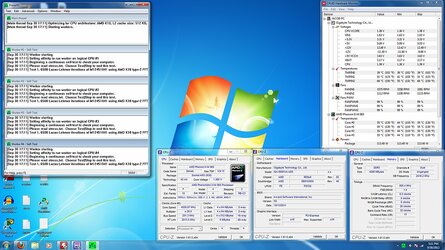It is usually a smart idea to disable all the green, power-saving, down-throttling technology that can cause instability in the higher overclock ranges.
In bios, we advise disabling: Cool N Quiet, Turbo, C1E, C6 and APM.
In Windows Control Panel Power Options we recommend configuring it to High Performance.
Sounds like your core temps are nice n' cool at this point but keep in mind that the FX CPUs core temp readings are usually skewed on on the cool side, often by about 15c.
Keep raising your multiplier by .5x increments until you cannot pass a 20 minute Prime95 blend test and then add a .025 increment of vcore. Of course, the relationship of overclock increase to voltage increase is far from linear. The last .1 or .2 ghz increments of speed gain usually take a lot more to achieve than the first .7 ghz increase. That's when you begin to "hit the wall". After finding where that wall is, then run longer Prime stress tests and make adjustments to top her off.
Well he already has 4.3 stable...4.4 isn't working so lets find out what voltages, temperatures, etc he is running first. 20c is not even close to real.
The reason for disabling power saving technologies isn't because of instability, but rather...causing stability.
C&Q disables automatically over a certain multiplier, I have not tested on FX but Phenom II this is 18.5, which is why AMD had to stop at 3.7 GHz X4s (980) without new stepping. Enable/disable C1E + C6 along with C&Q.
Turbo should be disabled because of voltage hike over already high voltages in OC situations, and frequency hike in single thread or lightly threaded workloads, where if pushing limits already will cause instability / damage
APM is new with FX CPUs, it will throttle the CPU when a predefined TDP limit within the CPU is reached. Prime95, heavily multithreaded programs tend to set this off. This is not the same as VRM/PWM Over-Current Protection which is a feature of motherboards, independent from whatever CPU is installed.
High Performance, I recommend too but usually the default Balanced works fine. Windows 7 works in tandem with universally defined features like C1E, C6, C&Q so if you forget one place, it should kick in in the other.
Thanks for the help. I already have core temp and prime 95 for testing, and the cpu ran stable at 21-24 degrees under full load of prime 95's blend. I only ran for about half an hour, but have stress tested for 8 hours straight on this speed with no hiccup in the past. So 5 is not attainable, stable at least huh? Hmmm might just stick with what you said 4.5 ish.
Your room is probably at least as warm as 21c so this number is just absolutely wrong.

I'd ask you to just list stuff out like "what idle and load temp, what idle and load CPU voltage, what CPU-NB clock, what CPU-NB voltage etc etc etc"
but most of that should be supplied with the screenshot.





